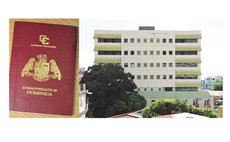Crime and tourism are everybody's business
The 16 January 2016 killing of Rose Wyatt, a native of Brazil who lived at the Sunshine Gardens in Calibishie has again raised the issue of the fragility of tourism and the adverse impact that crime in general has on that sector in Dominica and the rest of the Caribbean. But we believe that though Dominicans have talked the subject of escalating crime rates to death, very little has been done to affect the main causes. We keep talking while people continue to be robbed and killed.
There have been suggestions that last week's murder in Calibishie is just another one of the incidents of crime that has affected tourism in Dominica in recent times. We are aware that there have been several cases of assault against tourists here over the past few years. Some have been reported but the majority has been swept under rugs on the doorsteps of the offices of tourism officials.
For instance there was the killing of Joe Costello, a native of Dublin who lived at Paugua Bay House in Marigot. Last year too an Australian journalist who was covering a Test Match here was robbed when he went to an ATM to withdraw cash. The police department was apparently investigating that particular crime but so far it has made no arrests.
Additionally, a few years ago, a German citizen on holiday here with his Dominican girlfriend was accosted by a cutlass-wielding man at one of the isolated beaches in the northeast. And a few years ago an apparently deranged man terrorized tourists in the Roseau Valley for many weeks. Additionally, hotels and guest houses are routinely burglarized.
Of course, senseless crimes like those that we have just mentioned occur in virtually all tourism destinations but in Dominica, where tourism development is still in its mother's womb, these incidents have extremely serious repercussions because crime generally stunts the growth of tourism. Dominica boasts of being one of the least crime-ridden countries in the Caribbean but that is no reason to rest on our laurels. By the way, crime statisticians argue that Dominica's apparent low homicide figures (12 in 2015, for example) are misleading because if Dominica's figures are applied to a population of 100,000, Dominica's annual murder rate makes it one of the highest in the world. Dominica's population is approximately 70,000.
The experience of other countries of the Caribbean, especially Jamaica, indicates that if you ignore the conditions that breed crime, in a few short years we could have a crime crisis on our hands. You will recall that a few years ago Dr. Francis Severin, the then Head of the University of the West Indies Open Campus Dominica came to a similar conclusion in his analysis of the crime situation in Dominica but he was almost lynched by politicians of the ruling party because they apparently prefer Dominicans to bury their heads in the river and pretend that there is no crime to worry about in paradise. Dr. Severin argued that something has to be done to stop the trend or Dominica could become as crime-ridden as Jamaica. Many persons endorsed that view.
However, tourism officials contend that violent crime is hardly ever directed at tourists and that the recent murder in Calibishie was not a crime against tourists because Wyatt was the manager of a hotel and not a visitor. That may be true up to a point but we argue that the criminal who killed Wyatt would have attacked anyone, tourists or non-tourist who stood in his way. As the fallout from a high profile murder of a honeymooning couple in Antigua demonstrates the cost of a single incident can do incalculable damage to the tourism sector of any destination.
Crime has been a major constraint to the development of the Caribbean and leaders must now do much more than talk about the problem. According to the World Bank report: Crime, Violence and Development Trends, Costs and Policy Options in the Caribbean murder rates in the Caribbean are higher than in any other region of the world and assault rates are significantly above the world average. The causes of such alarming statistics are well known. For instance, we know that Caribbean countries are fast lanes for the cocaine traffickers of Latin America and that gun ownership, an offshoot of the drug trade, is the fuel that generates violent crimes. Youth violence fuelled by alcohol abuse, we are told, has become a major threat to public health and criminal deportees from the United States have directly and indirectly contributed to the increase in crimes in the region. Additionally, the criminal justice system is ineffective and inefficient; and the emergence of the gang culture among our youth is one of the most disturbing aspects of the growing crime culture.
Most importantly, the root of today's lawlessness has been attributed to the loss of respect for the State and the rule of law. This situation is acerbated by the perception of high levels of corruption in high places.
The point we need to stress here is that much more needs to be done to control the spate of crimes in Dominica before it is too late. Crime committed against Dominicans is bad enough but it is worse when it is directed against the fragile but absolutely important tourism industry. Crime, as well as tourism, must quickly become everybody's business.




